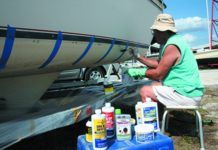Water Heater Plumbing
I am planning to install on my 35 sailboat a hot water heater using the closed circuit cooling system of my engine, a Westerbeke 4-107, and have been told of two ways of doing this.
One recommendation is to plumb into the cooling system just before the heat exchanger so that all the engine cooling water goes through the heater. As the engine cooling water pipes are 1-1/2″ diameter, and the heater pipes are 5/8″ diameter, I am concerned there will be a serious restriction in the cooling water flow and consequent engine overheating.
Another suggestion is that a cylinder plug just before the thermostat and another one on the exhaust manifold be removed and replaced with nipples and 5/8″ hose connected to the heater. I can see this working when the thermostat is closed but not when the engine is hot and the thermostat is fully open.
I would appreciate your recommendations.
Brian Pollard
Mount Desert, Maine
Your concerns about running all water through the water heater are justified. The service manual for your engine shows the water heater plumbed to the thermostat housing outlet and the exhaust manifold. This gives you the hottest water available. You may have the thermostat issue backwards. There will be no water circulating through the water heater when the engine is cold and the thermostat is closed. As soon as the thermostat opens, water will begin circulating through the heater. Water in the heater will help cool the engine circulating water.
The manual also notes that the top of the heaters internal coil be no higher than the engine pressure cap. If this cannot be avoided, a remote fill tank must be installed so that it is the highest point of the circuit.
It also says that the piping between the engine and heater should rise continuously from the heater to the engine so that trapped air will rise automatically from the heater to the engine. If the system does trap air, then a petcock or other means is needed to bleed air from the system.
Sail Prices
I keep reading how sailors order new sails based primarily on price. Before computer-designed sail programs were developed, one selected a sailmaker based on his design expertise, especially if one was racing. Has computer design technology and fabric technology reached a level with major (or most) sailmakers that the only difference today is in price? I priced a sail recently with four major sailmakers and came up with prices that varied as much as 35%. How does one judge beforehand whether the lowest price is best or just cheap; and, the highest price is actually the very best sail-or just highest priced?
Harry Walcoff
via e-mail
The February 1, 1999 issue has a special report on the sailmaking industry. The answer to your question, we think, is that just about any loft can make a good sail, and any loft occasionally makes mistakes and produces a bad sail. They all tout their various designs, almost exclusively designed by computers-which mostly focus on how the panels are oriented. Some push Dacron for cruisers, others are making cases for laminates. Most of the designs are pretty good, but differences in materials can be significant.
When comparing bids, check cloth weights, standard features such as corner reinforcements and options such as reef points and leech lines.
When you see that people win races with nearly every brand, you begin to think that its mostly hype.
Fall shows are a good time to price sails as discounts are offered to help keep the workers busy over the slow winter months.
The significant price differences you were quoted are fairly typical of our surveys, though the same lofts are not necessarily always the highest or lowest.




































